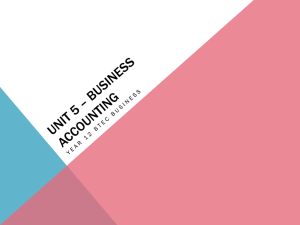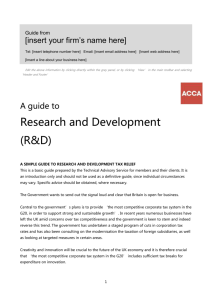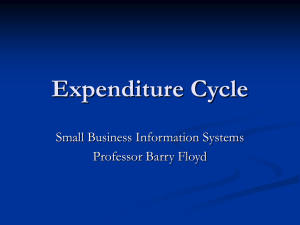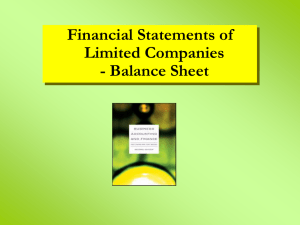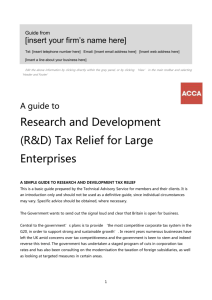A practical guide to claiming R&D tax relief
advertisement
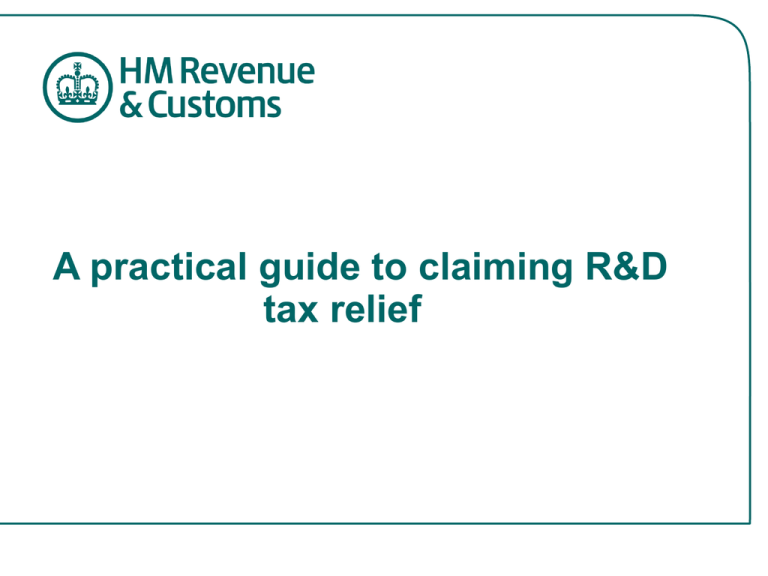
A practical guide to claiming R&D tax relief How the relief works • R&D tax credits – company tax relief which gives an increased deduction for certain qualifying expenditure. • The increased deduction reduces the taxable profits and hence the amount of corporation tax payable • Loss making small or medium companies can in certain circumstances surrender the losses arising as a result of the increased deduction in return for a payable credit. What is R&D for tax purposes • The DTI guidelines explain what is meant by R&D for a variety of tax purposes. • R&D takes place when a project seeks to achieve an advance in science or technology. • Activities which directly contribute to achieving the advance through the resolution of scientific or technological uncertainty are R&D. • A scientific or technological uncertainty exists when knowledge of whether something is scientifically possible or technologically feasible, or how to achieve it in practice, is not readily available or deducible by a competent professional working in the field. • Uncertainties that can be readily resolved by a competent professional working in the field are not scientific or technological uncertainties. Qualifying R&D expenditure • Must not be capital expenditure • It must be expenditure attributable to relevant R&D directly undertaken by the company or on its behalf • It is expenditure on: – Staffing costs – Software or consumable items – Externally provided workers – Subcontracted R&D Some other conditions • The amount of payable credit claimable is limited to the amount of the total PAYE and NIC liabilities. • The claim for the payable credit must be made in the company tax return or amended return. • Minimum spend = £10,000 • The R&D expenditure must not be subsidised • Record keeping. Making a claim • Identify the R&D project and the activities included within it. • Identify the expenditure incurred directly in carrying out those activities. • Check whether the company is small/medium • Calculate the relief due • Enter R&D amount on CTSA Return (long version – CT600 version 2) Help in making a claim • Help in putting a claim together can be found on the HMRC website at http://www.hmrc.gov.uk/randd/index.htm • Your R&D unit will also be able to provide advice on what can be included in a claim A quick R&D example R&D Example – Ecowash Ltd • Ecowash Ltd is a small company and after reviewing the published guidance, it has come to the conclusion that it’s activities leading to the development of a new biodegradable cleaning product are R&D in line with the DTI guidelines. • The expenditure relating to those activities was revenue expenditure and has been deducted in the accounts to arrive at an accounting profit of £80,000. After various tax adjustments its profit for tax purposes is £85,000. • The company has identified its R&D expenditure as follows; A). Staff costs - £300,000 • An analysis has been provided and these include: • £180,000 on technical staff (who worked directly on solving the scientific and technological uncertainties posed by the project) • £30,000 on sales staff (who canvassed customers as to the fragrance and packaging of the new product) • £50,000 on office and support staff • £40,000 on scientific staff employed via a staff agency Staff costs Allowable • Only the costs of those staff directly and actively engaged in the R&D are qualifying expenditure and so the costs relating to the sales and support staff will not qualify for relief. • The qualifying staff costs are therefore £220,000 • Comprising • Technical Staff £180,000 • Scientific Staff £40,000 Software & Consumables • B). Software and Consumable items - £78,000 • Including fuel and energy costs directly incurred in the R&D and the cost of chemicals, ingredients, and lab equipment. • Software and Consumable items Allowable • As these directly related to the R&D activity they are all eligible for relief • The qualifying software and consumable items costs are therefore £78,000 C). Subcontracted R&D costs - £175,000 • The analysis provided shows that the company subcontracted specialist development activities to another unconnected company at a cost of £175,000. • Subcontracted costs Allowable • Ecowash Ltd can claim 65% of the costs relating to the R&D work it subcontracted to another unconnected company. • The qualifying subcontracted costs are therefore £175,000 x 65% = £113,750. Enhancement • The enhancement due is therefore • A). Staff costs • B). Software & Consumables • C). Subcontracted costs – • £411,750 x 50% (£) 220,000 78,000 113,750 411,750 = £205,875 Adjustment for Corporation Tax • • Adjusted Profits £ 85,000 Less R&D enhancement £205,875 • • Losses arising £120,875 • The loss arising is £120,875 x 16% = a payable credit of £19,340 There is no loss remaining to carry forward. The company decides to surrender the losses arising in return for a payable credit. The payable credit is at a rate of 16% of the surrenderable losses.







